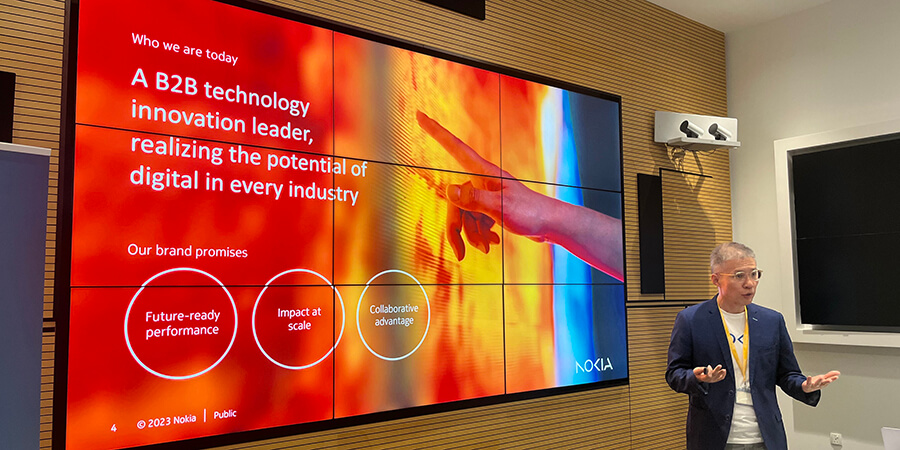Nokia has presented its updated company and technology strategy at the Amplify Singapore event. The goal is to support Singapore's digital transformation and economic growth by positioning Nokia as a leader in innovation. This will involve developing next-generation network solutions and B2B technology innovations that will help Singaporean enterprises and communication service providers (CSPs) maximize their digital potential.
The head of Nokia Singapore, Ngiam Ming Kin, gave the introductory remarks before revealing the company's refreshed brand strategy and providing an update on Nokia's position in Singapore. Meanwhile, the Chief Technology Officer of Nokia Asia Pacific and Japan, Terence McCabe, gave a presentation that followed, highlighting Nokia's technological leadership and advancements.
Nokia discussed the current state of 5G technology in the country and how they plan to support the nation's move towards 6G through case studies. They also demonstrated how their innovative solutions can help Singapore achieve its Digital Connectivity Blueprint and other Smart Nation initiatives by providing mission-critical solutions to enterprise customers.
The demonstrations showcased Nokia's latest products and technologies across their portfolio of enterprise, mobile networks, cloud and network services and network infrastructure technologies. These were curated from Nokia's participation at the Mobile World Congress 2023 and highlighted how Nokia is ready to shape the future of Singapore's industries and drive socio-economic growth by assisting Singaporean CSPs and enterprises in their 5G and digital transformation journey.
At the event, various innovative solutions were presented, including the MX Industrial Edge, which is an on-premise edge solution that can speed up the digital transformation of operational technology. It combines the agility and simplicity of an edge-as-a-service model with a high-performance, resilient, and secure edge architecture designed to meet the mission-critical needs of asset-intensive industrial environments. This solution unlocks business-critical use cases for enterprises, such as real-time monitoring of video feeds and alerts and advanced video analytics solutions for mission-critical applications such as quality assurance or safety.
Another solution showcased was the NetGuard Cybersecurity Dome, which is an award-winning security orchestration solution with pre-built 5G use cases for network security assurance. Security orchestration teams can select 5G use cases from a comprehensive catalog to cover the entire telecommunications technology, from the RAN to Transport and Core. These services are based on an XDR capability that collects, aggregates, analyzes and correlates security data from a variety of sources, enriching it with a telecommunication context to help security operations teams assess business risks, improve decision making and control costs and risks.
Nokia's optical network products and solutions were also presented, which enable scaling without limits to enable the foundational connectivity for networked communications. Nokia's solutions scale from the network edge and across long-haul/core and subsea links while simplifying network operations to build smarter, more automated networks that streamline service delivery and lower network total cost of ownership. Nokia's network automation solutions help CSPs, webscale companies, and enterprises grow revenues, accelerate service deployment and build more programmable, responsive, efficient and reliable IP and optical networks.
Nokia's ReefShark chipsets were also highlighted, which enhance the company's already comprehensive 5G end-to-end network portfolio by increasing the intelligence and performance of massive MIMO antennas and AirScale System Modules. Developed in-house and leveraging the company's extensive experience in silicon design, as well as the company's expertise in antenna development for mobile devices and Nokia Bell Labs innovation in Artificial Intelligence to realize high-performance and efficient network solutions.
Nokia has developed platforms called PSE-6s to help network operators manage their optical transport networks. These platforms can handle the increasing demand for capacity and provide ultra-high-speed services like 400 GE and 800 GE while reducing power consumption.
Nokia's Quillion chipset supports various modules and offers power savings, competitive features and innovations. Nokia's FP5 network processing silicon provides a significant increase in IP network capacity and power efficiency while protecting network traffic from security threats. It also delivers integrated line rate encryption for L2, L2.5, and L3 network services at speeds up to 1.6 Tb/s and reduces power consumption by 75% compared to previous generations.
Nokia's best-in-class digitalized portfolio, Network Planning and Optimization (NPO), was also presented, which enables sustainable business growth for mobile networks. It enhances customers' performance by delivering innovative portfolios, tools and processes. Nokia's Automation and Digitalization portfolio positions network performance at its center. It helps drive portfolio evolution to support new technology adoption and RAN disaggregation with the onset of O-RAN and vRAN. It brings out environmental sustainability through the design of Mobile Networks and the delivery of NPO services.
Furthermore, Ngiam Ming Kin stated that they are committed to supporting Singapore's efforts towards digital transformation and improving the city's digital infrastructure in accordance with the Digital Connectivity Blueprint.
“With our renewed brand strategy, we look forward to driving technological advancements not only in 5G but also playing an active role in shaping the future of technology. We look forward to supporting our customers and partners to continue unlocking the remarkable potential of their networks and creating a transformative presence for Singapore’s future,” he concluded.






